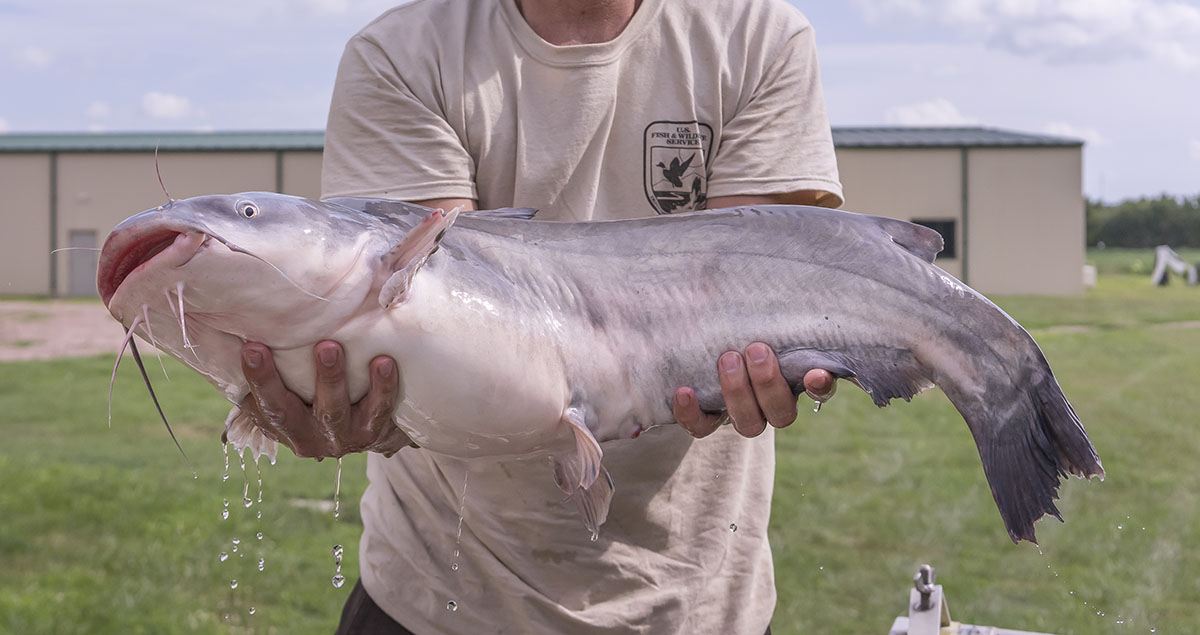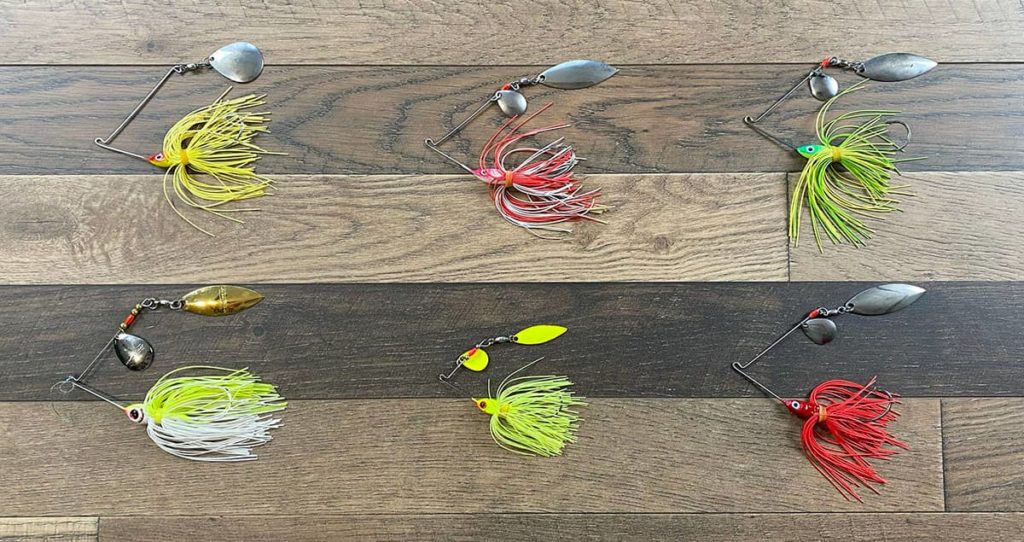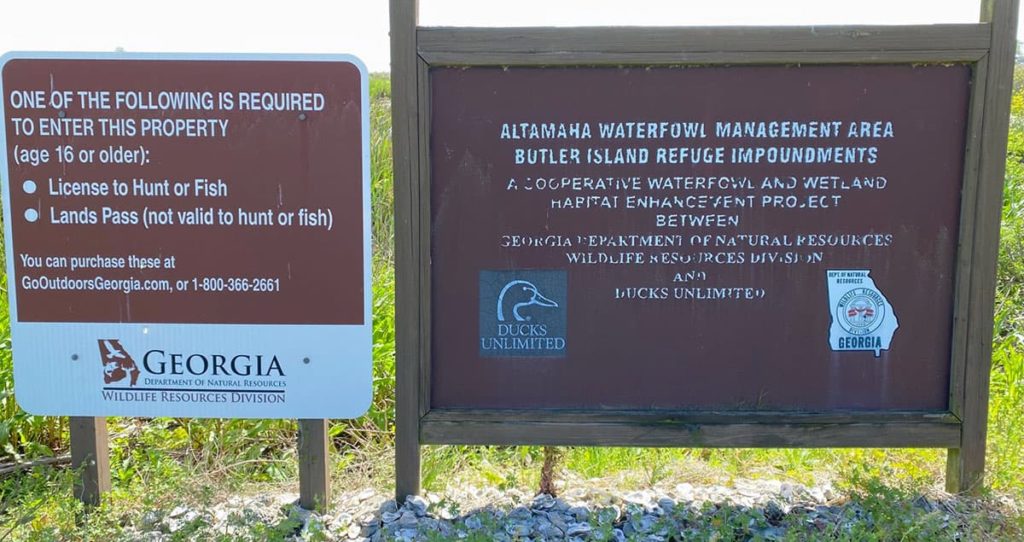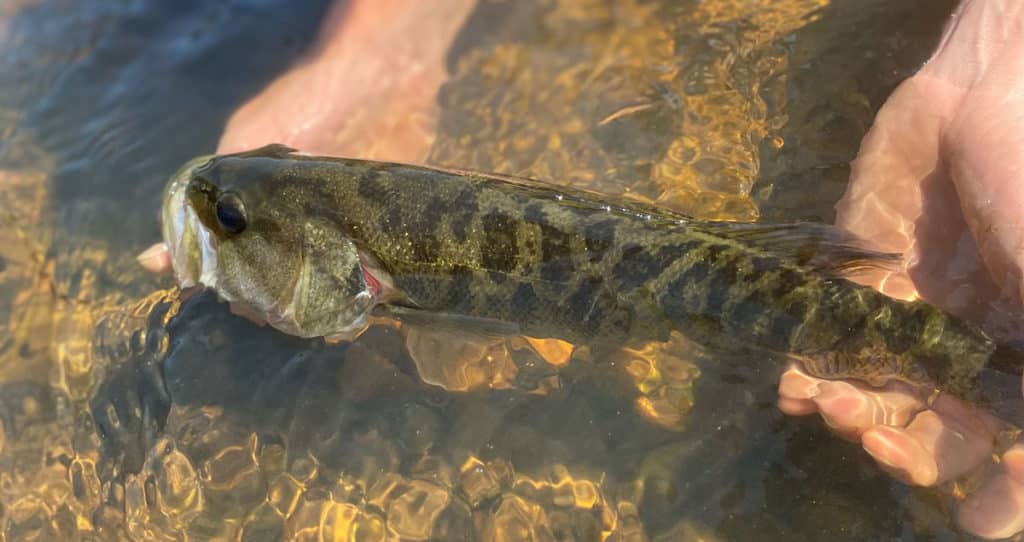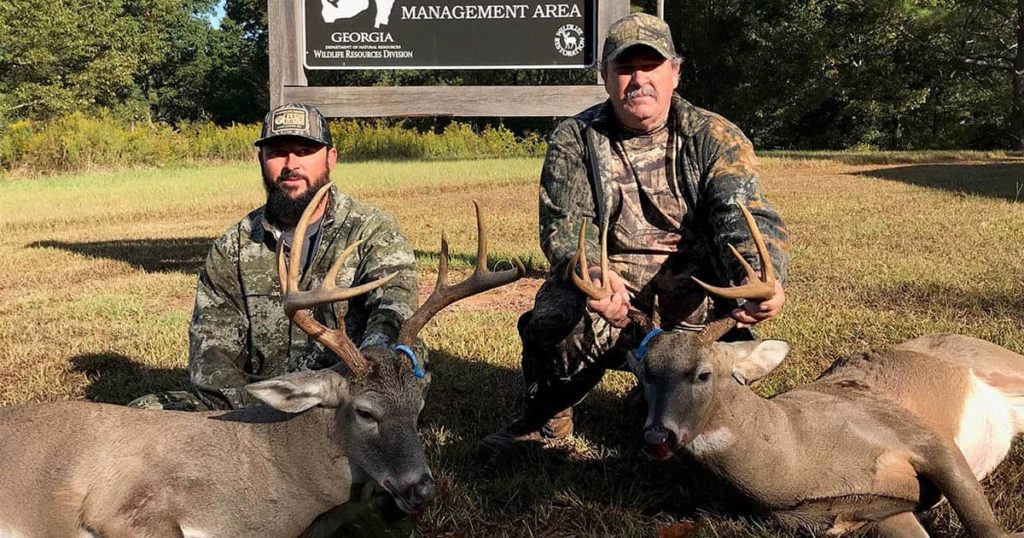When it comes to freshwater fishing in Georgia, nothing compares in size and fight to the blue catfish (Ictalurus furcatus). Native to the Coosa river in the northwest corner of the state, the blue catfish has since been introduced into the Chattahoochee, Flint, Ocmulgee, Oconee, Altamaha, Satilla and Savannah River basins, creating abundant fishing opportunities for Peach State anglers.
In this comprehensive guide, we will explore the best spots for blue catfish fishing in Georgia, essential gear, effective techniques, and the importance of conservation and ethical angling practices.
About Blue Catfish
Appearance
The blue catfish is a large, robust fish with a slate blue to grayish body that fades to a white belly. It has a smooth, scaleless skin and a deeply forked tail, distinguishing it from other catfish species. Its head is large and wide, with a straight-edged, flattened dorsal profile.
Blue catfish possess sharp, backward-facing spines on their dorsal and pectoral fins, which can inflict painful wounds. The species is characterized by its prominent barbels, or “whiskers,” around the mouth, with one pair of long, slender barbels on the upper jaw and two pairs of shorter barbels on the lower jaw. These whisker-like appendages are sensory organs that help the fish locate food in murky waters.
Size
Blue catfish are known for their impressive size, with typical adult specimens measuring 20 to 40 inches in length and weighing between 20 and 40 pounds. However, these fish have the potential to grow much larger. Blue catfish can reach lengths of up to 60 inches and weigh well over 100 pounds, with the largest specimens often found in rivers and reservoirs with abundant food sources.
The current Georgia state record for a blue catfish, caught in 2020 by Tim Trone from the Chattahoochee River, weighed an astounding 110 pounds and 6 ounces, showcasing the true potential of this species to reach trophy proportions.
Habitat
Understanding the preferred habitats of blue catfish is essential for increasing your chances of success on the water. These adaptable fish can be found in a variety of environments, but they have some specific preferences that can help you pinpoint their location.
Blue catfish predominantly inhabit large rivers and reservoirs, where they can find a diverse range of food sources and ample cover. They are often found in areas with deep channels and drop-offs, as these areas provide access to both deep water for refuge and shallow water for feeding.
Structure and cover play a crucial role in attracting blue catfish, as they provide hiding spots and ambush points for hunting prey. Submerged trees, rock piles, bridge pilings, and underwater ledges are all prime examples of structures that can hold these large predators.
Current also plays a significant role in blue catfish behavior, as these fish are often found in areas where the water is moving. The confluence of rivers, bends in the channel, and areas downstream of dams are all places where the current can concentrate food and attract blue catfish.
Additionally, pay attention to water temperature, as blue catfish will move to different parts of the water column based on the temperature. They prefer water temperatures between 70°F and 85°F and will often seek cooler, deeper waters during the hot summer months and shallower areas during cooler seasons.
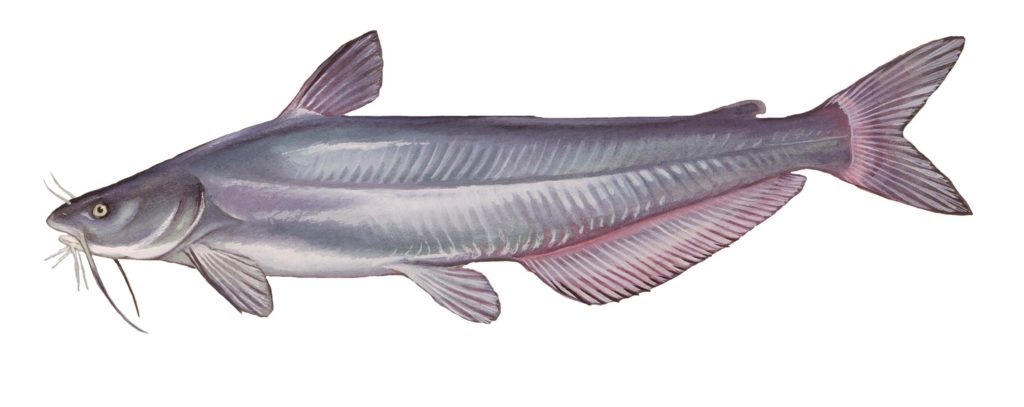
Where to Catch Blue Cats
Altamaha River
The Altamaha River is the largest free-flowing river in Georgia and is home to an abundant blue catfish population. Key areas to target blue catfish include deep holes, outside bends, and the confluence of the Oconee and Ocmulgee Rivers. The area surrounding the US Highway 84 bridge in Doctortown also offers promising fishing opportunities.
Chattahoochee River
The Chattahoochee River is another prime destination for blue catfish anglers in Georgia. West Point Lake, formed by the West Point Dam on the Chattahoochee River, provides an excellent environment for blue catfish. Target deep holes, submerged timber, and the tailwaters below the dam to increase your chances of success.
Lake Oconee
This 19,000-acre reservoir is known for its excellent blue catfish fishing. The lake has a variety of structures, including submerged timber, docks, and riprap-lined banks that can hold blue catfish. Key areas to focus on include the Richland Creek arm and the main lake near the Georgia Power Dam.
Lake Seminole
Located on the border between Georgia and Florida, Lake Seminole is a 37,500-acre reservoir with a thriving blue catfish population. The lake features a mix of shallow flats, deep channels, and abundant cover, making it an ideal habitat for blue catfish. Focus on the deeper channels near the Flint and Chattahoochee River arms, as well as the tailrace waters below the Jim Woodruff Dam.
Clarks Hill Lake
As one of the largest reservoirs in the Southeast, Clarks Hill Lake offers ample opportunities for blue catfish fishing. The 71,000-acre reservoir features deep channels, flats, and numerous underwater structures that can hold blue catfish. Key areas to target include the confluence of the Savannah and Broad Rivers, as well as the numerous creeks that feed into the lake.
By focusing on the preferred habitats of blue catfish and visiting some of Georgia’s top fishing destinations, you can significantly improve your chances of reeling in a trophy-sized catch. Remember to practice responsible angling and adhere to all local regulations to ensure the long-term health of Georgia’s blue catfish population.
Essential Fishing Gear
Having the right gear is crucial for a successful blue catfish fishing trip. Here’s a list of essential equipment to help you land a trophy catch:
Rod and Reel Selection
Choose a medium-heavy to heavy action rod between 7 and 9 feet in length, with enough backbone to handle large fish. Both baitcasting and spinning reels can be effective. Baitcasting reels often provide more power and control, while spinning reels are easier to use for beginners. Use a braided or monofilament line with a minimum strength of 20-30 pounds. Braided lines offer better sensitivity and less stretch, while monofilament lines are more abrasion-resistant and easier to handle.
Terminal Tackle
Circle hooks (size 4/0 to 10/0) are recommended for blue catfish fishing, as they are less likely to cause injury to the fish and provide better hook-up ratios. Egg, no-roll, or pyramid sinkers (1 to 5 ounces) are commonly used, depending on the current and depth of the fishing spot. Barrel or ball bearing swivels help prevent line twist and are useful when fishing with live or cut bait. Use a strong, abrasion-resistant leader material such as fluorocarbon or heavy monofilament (30 to 60-pound test).
Bait Options
Shad, herring, and bluegill are all effective live bait choices for blue catfish. Use a large hook and a strong line to handle the bait and fish. Fresh cut bait, such as shad or herring, can be even more effective than live bait. Make sure to keep the bait fresh and change it often. Commercially available stink baits can be effective, but they are generally less productive than live or cut bait.
Additional Gear
A large, sturdy landing net with a long handle is essential for safely landing big blue catfish. A good pair of fish grips will help you hold the fish securely while removing the hook or posing for a photo. A flexible measuring tape is useful for recording the length of your catch, especially if you plan to release the fish. A durable, accurate scale is necessary for weighing your catch and determining if you’ve landed a potential state record.
Fishing Techniques
There are several effective techniques for targeting blue catfish in Georgia. Here are some popular methods and catfish rigs to help you catch more fish:
Anchored Fishing
Anchor your boat upstream of the target area, allowing your bait to drift naturally with the current. This can be particularly effective near underwater structures and drop-offs. Use a Carolina rig or a three-way rig to keep your bait off the bottom and in the strike zone. Adjust the leader length and sinker weight as needed to keep the bait at the desired depth. Watch your rod tip closely for any signs of a bite. Blue catfish bites can range from subtle taps to aggressive pulls. Set the hook firmly once you feel a solid bite.
Drift Fishing
Identify areas with suitable depth and structure for blue catfish. Drift along channels, drop-offs, or flats, allowing your bait to cover a large area and search for active fish. Use a bottom-bouncing rig or a three-way rig to keep your bait at the desired depth. Adjust the length of your leader and the weight of your sinker to fine-tune the presentation. Maintain a slow, controlled drift by adjusting your boat’s speed and direction with the trolling motor or the wind. Keep your lines at a comfortable distance from the boat to avoid tangling and spooking fish.
Jug Fishing
Jug fishing involves using floating jugs with attached lines and hooks to catch fish. Make sure to use sturdy jugs and heavy-duty lines to handle large blue catfish. Weight the jugs to keep them upright and stable in the water. Keep a close eye on your jugs, watching for signs of movement or submersion. Retrieve the jugs carefully, using a gaff or a long-handled net to secure the fish. Always check local regulations regarding jug fishing, as rules may vary regarding the number of jugs allowed, markings, and retrieval requirements.
Seasonal Strategies
Blue catfish behavior and feeding patterns can change throughout the year. Here are some general tips for fishing in different seasons:
Spring: As the water temperature rises, blue catfish become more active and move to shallower areas to feed. Look for areas with abundant baitfish, such as flats, creek mouths, and shallow coves.
Summer: During the hot summer months, blue catfish often seek cooler, deeper waters. Target deep holes, channels, and ledges near main river channels. Night fishing can be productive in the summer.
Fall: As water temperatures cool, blue catfish will move back to shallower areas to feed. Look for baitfish schools and focus on areas with structure or cover.
Winter: Blue catfish tend to be less active in cold water but can still be caught with patience and persistence. Target deep holes and structure in the main river channels, using slow presentations and larger, fresh baits to entice bites.
Georgia Regulations
A valid Georgia fishing license is required for anglers 16 years of age and older. Check the Georgia Department of Natural Resources website for specific requirements, exemptions, and license purchase options. Follow all size and bag limit regulations for blue catfish. These regulations help ensure the long-term sustainability of the fishery. Consult the Georgia Department of Natural Resources for the most up-to-date information on limits and regulations. Be aware of any seasonal restrictions that may apply to specific waterways or fishing methods.
Final Thoughts
Blue catfish fishing in Georgia offers exciting opportunities for anglers to reel in trophy-sized catches. By following this comprehensive guide, you can enhance your skills, improve your chances of success, and ensure a sustainable future for the sport.
Whether you’re a seasoned angler or just starting, it’s essential to practice responsible angling and share the joys of fishing with future generations. So grab your gear, hit the water, and get ready to reel in the giants!

